Blackbirds are notorious for being able to mimic the sounds they hear as they hop about the celestial chimney pots of suburbia. Ice cream van jingles, phone ring tones, car alarms and ambulance sirens – they can do the lot.
John Drinkwater – born in Leytonstone, London – writes about the song of the blackbird in Loyalties – the anthology of his poems that was illustrated by Paul Nash and published in 1919.
A recent London trip allowed me to indulge my current Paul Nash craze. First there was the Imperial War Museum where I was less than impressed by the current First World War exhibit. Not a patch of ye olde Trench Experience of yesteryear, but there you have it. At least there was The Mule Track.
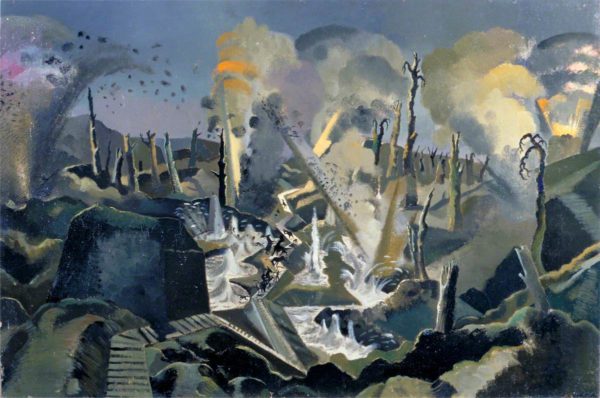
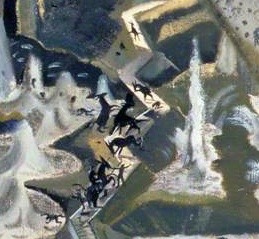
It’s hard to see the actual mule train overshadowed as it is by the explosive violence in a shattered landscape. .
Here is the horrifying detail from the center of the painting that shows the mules rearing in panic at the nearby explosion as water from a flooded trench bursts up like a fountain. The sky is full of yellow grey smoke and rubble thrown up by the shell. The actual track seems folded up like a collapsing Jacob’s ladder and one of the drivers has been blown off to the side. It’s a landscape of fractured planes and blasted trees; a place of violence and shock.
Paul Nash – like his younger brother John – served in the Artists Rifles and was then appointed an official war artist for both world wars. This work was commissioned by the Ministry of Information.
The war had a profound effect on Nash. His biographer Anthony Bertram said: “most of the other artists saw an explosion; but the explosion took place within Nash.”. He expressed that anger in his paintings.
While at the front, he wrote to his wife:
I am a messenger who will bring back word from the men who are fighting to those who want the war to go on for ever. Feeble, inarticulate will be my message, but it will have a bitter truth and may it burn their lousy souls.
He was physically and psychologically damaged by the war. It left him with what we now call PTSD and a mental breakdown. A gas attack at Passchendaele in 1917 ruined his lungs and contributed to his premature death by pneumonia at the age of 57 in 1946.
And so on to the British Museum for the exhibit Places of the Mind: British Watercolour Landscapes 1850–1950 – an exhibition of work drawn mostly from the Museum’s own collection and devoted to landscapes by British artists in the Victorian and modern eras – the century that followed the death of J M W Turner. It includes works by James McNeil Whistler, Edward Burne-Jones, David Jones, John Singer Sargent, Muirhead Bone, John Nash, John Minton, Eric Ravilious, Henry Moore and Graham Sutherland and – of course – Paul Nash.
1850 – 1950 was a turbulent one hundred years of change and conflict and the work reflects that. These landscapes are constructs of the mind and imagination conveying the physical properties of a scene together with an effort to capture a distinct sense of place and meaning.
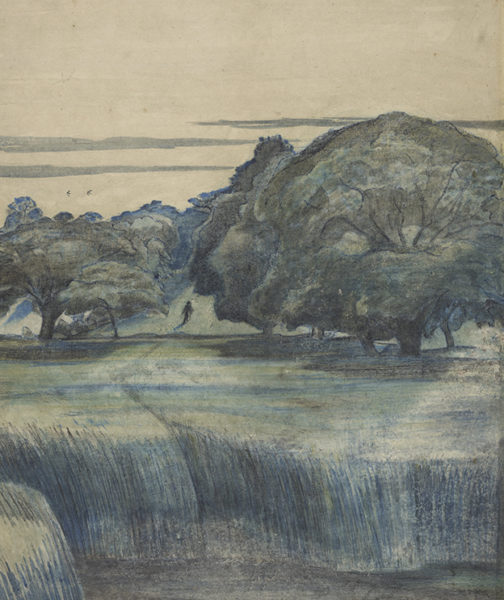
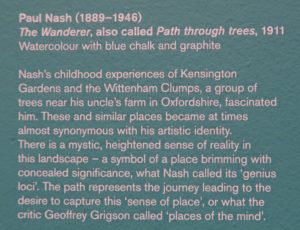
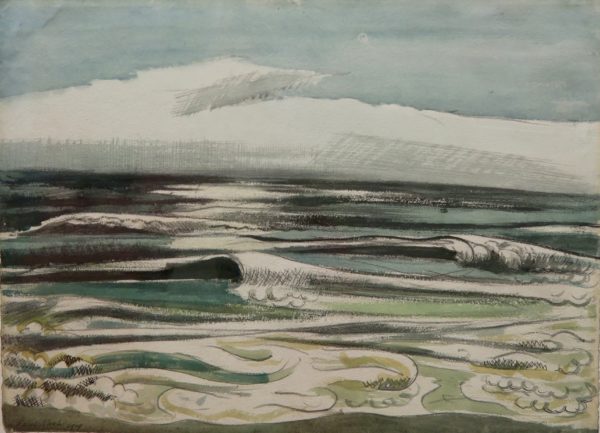
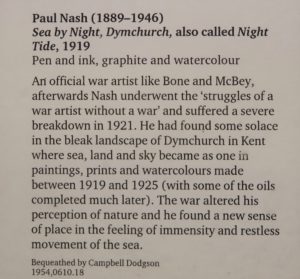
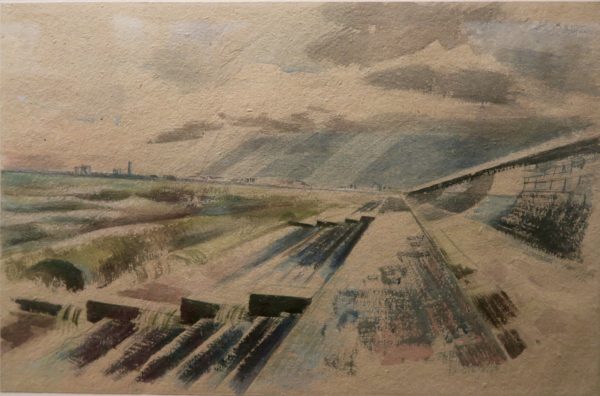
So interesting to see the abstract geometrical lines merged with the flow of the water and the natural contours of the clouds.
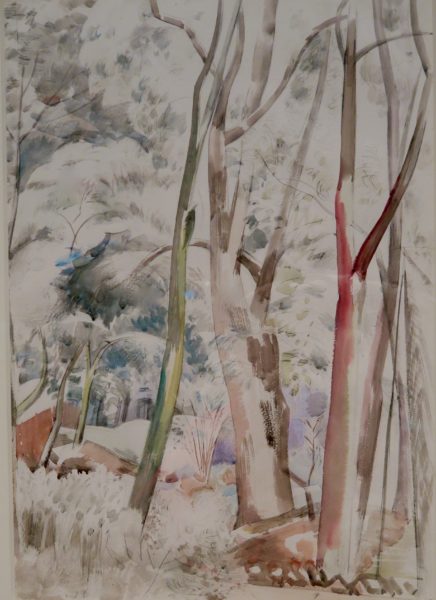
What a wonderfully hopeful picture. Spring is coming indeed and perhaps the dark times are in the past.
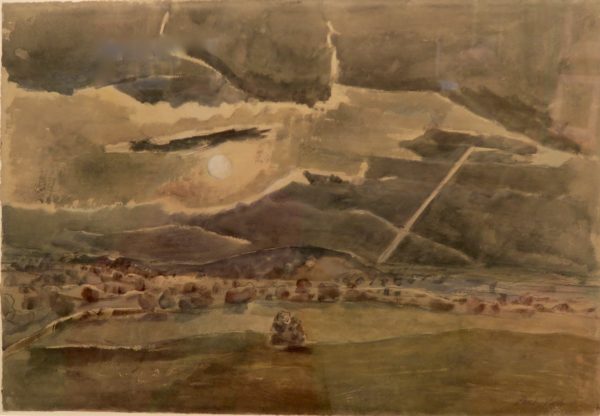
This is Madams in Gloucestershire which became a place of serenity and refuge during WW2. For Nash it was an “other” world.
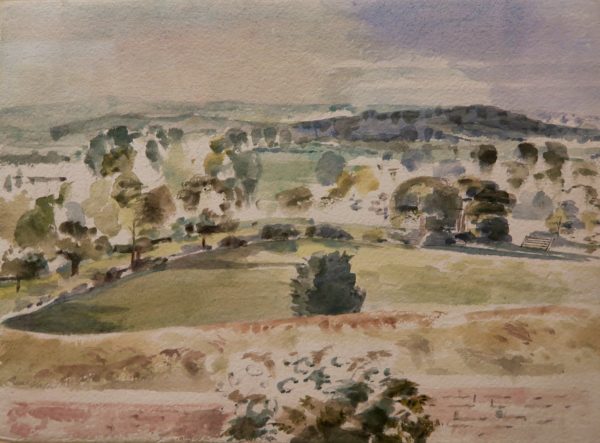
Another painting of Madams – his personal Cotswold paradise.
I’ve just ordered a copy of Nash’s autobiography – Outline – so this Nash phase doesn’t look like stopping anytime soon.
But – “Where’s the poem?” you ask. Turns out that Nash did set out to be a poet as well as an artist but decided that prose was a better medium or him. He did design and illustrate many books of poetry though, the first if which was John Drinkwater’s Loyalties 1919. Drinkwater – who was already hopelessly outdated by the time of this publication – was still writing the Georgian verse that the war and T.S.Eliot (and others) had rendered hopelessly out of step with the times.
Here is Blackbird – you have to love those celestial chimney pots! It’s followed by two of Nash’s wood engravings used to illustrate the verse.
Blackbird
He comes on chosen evenings,
My blackbird bountiful, and sings
Over the garden of the town
Just at the hour the sun goes down.
His flight across the chimneys thick,
By some divine arithmetic,
Comes to his customary stack,
And couches there his plumage black,
And there he lifts his yellow bill,
Kindled against the sunset, till
These suburbs are like Dymock woods
Where music has her solitudes,
And while he mocks the winter’s wrong
Rapt on his pinnacle of song,
Figured above our garden plots
Those are celestial chimney-pots.
by John Drinkwater
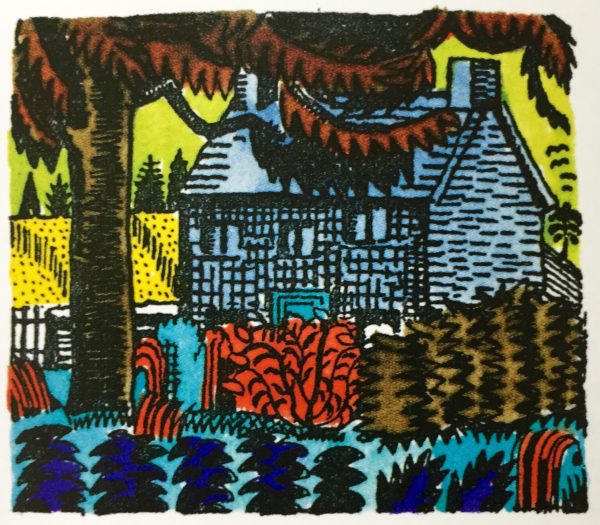
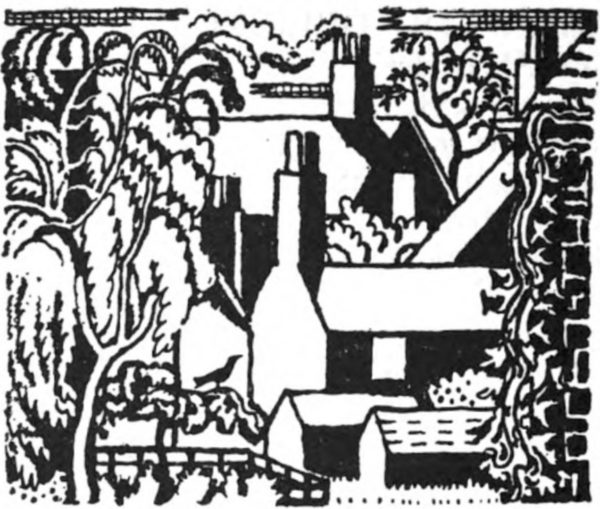
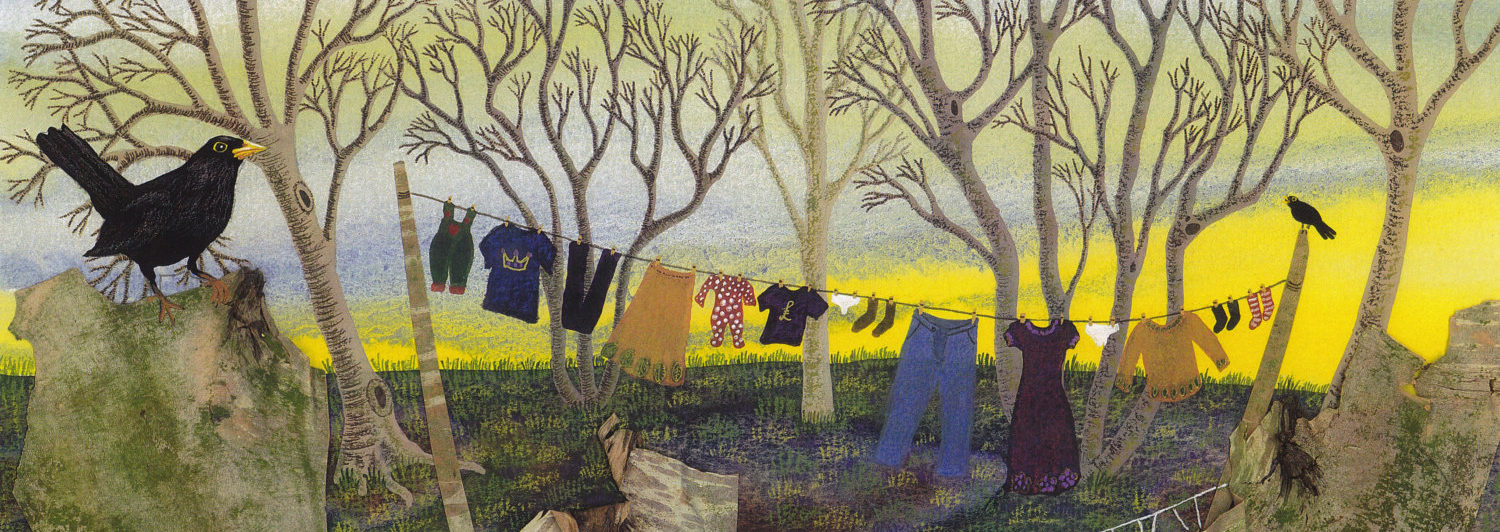


“I do not know which to prefer,
The beauty of inflections
Or the beauty of innuendoes,
The blackbird whistling
Or just after.”
I do know that poem but it’s always good to have another read. Poetry – like birdsong – is not just a one-off experience! So – thank-you.
Here is another poem about Blackbirds:
https://www.poetryfoundation.org/poems/45236/thirteen-ways-of-looking-at-a-blackbird
Which is new to me but I’m sure you know …
I loved the featured image of the Blackbird so much that I’ve sought permission from the artist to feature it on my post ‘Ode to the Countryside’
The original painting is entitled – “Morning has broken”- by Yorkshire artist Liz Marsh (Clarke). This fantasy painting celebrates the joy of a new day with a few references to a well known nursery rhyme …
Here is a link to her Gallery: http://www.the-elm-gallery.co.uk/prints_mystical_a3.html
Liz is is a mixed media artist whose work, which encompasses flowers, foliage, birds, animals, landscapes and mystical themes, is characterised by strong, vibrant colours. Her paintings are inspired by the force and beauty of the natural world and the pure joy of colour. Some of them have mystical or spiritual elements in them, or have a slightly surreal quality – “pigments of the imagination”. …
Clive´s last blog post ..A Hunting of Raptors
Thanks Josie, I don’t think I’ve come across Munro before, although I have a vague memory of the “Not So Stories” – a fascinating enigmatic writer. His article on the “Birds of the Western Front” showed great insight into bird behaviour and showed just how resilient Birds and nature can be. It’s quite amazing!
Munro can be wickedly witty and sometimes macabre. A P.G. Wodehouse with a stronger satirical bite. Hope you enjoy discovering him and yes – that account of birds in France suggests he knew his birds. So many WW1 writers speak of the birds. When all you can see is sky perhaps they take on greater significance. One of my favorites is “Returning, We Hear the Larks” – Isaac Rosenberg. https://www.poetryfoundation.org/poems/57223/returning-we-hear-the-larks
Henry Douglas-Home in his book ‘Memories of Birds’ writes of a Blackbird, which he recorded above the Birgham Dub on Tweed, imitating the opening of Mendlesshon’s ‘Second Symphony’. It was note perfect and of the purest rendering (Francis Collinson).
Mendelssohn would be a big improvement over the ice-cream van! But how did the bird hear the music to imitate? Wondering whether this is a case of the composer imitating a bird.
And you got me thinking about the starling and the mockingbird (the latter are very bold – I once saw a mockingbird swoop down and peck the backside of a large cat that was strolling across the garden.)
And then I found this: “There is a reliable report of a starling in a London suburb that cried like a baby, and other starlings imitated V-1 flying bombs in London towards the end of World War 2. Less reliable – though certainly within the bounds of credibility – is the account of a starling that mimicked a referee’s whistle and upset a football match.”
https://www.bl.uk/the-language-of-birds/articles/birds-that-imitate-birdsong
A V-1 flying bomb! Much worse than Mr. Softee.
And I’ve been enjoying looking at Ethelbert White. Haven’t tracked down that particular painting yet but – there’s still time!
Thanks Clive.
For a charming and prosaic account of British Birds and their songs here is a book which, if you haven’t come across it before, is hard to beat – ‘The Charm of Birds 1936 by Sir Edward Grey’ – filled with reminiscences of the birds he had seen, particularly on his Fallodon estate. From January through December, he devoted a chapter to each month in order to highlight those birds, be they migrants or natives, who visited him each year, and who charmed him with their songs.
He served as foreign secretary from 1905 to 1916, and was Ambassador to the United States between 1919 and 1920.
He is perhaps most famously known for his remark to a friend on the eve of the United Kingdom’s entry into the First World War.
“The lamps are going out all over Europe, we shall not see them lit again in our life-time”
I didn’t know that about Grey. Thanks for the tip.
Interesting that H.H. Munro -“Saki” – went to the House of Commons to hear Sir Edward Grey on August 3rd 1914. He too knew his birds and wrote the moving account of birds on the Western Front that I expect you already know. https://www.josieholford.com/window/
Off to check out Ethelbert White.
You could perhaps also add Ethelbert White, “The Deerpond” to the list.
Clive´s last blog post ..A Hunting of Raptors
Sorry! It was called ‘Wooded Landscape (Deerpond)’
I’ve sent you an email of the print!
Paul Nash is one of my favourite artists too. I’ve never seen some of these before. And that colour woodcut is quite gorgeous. Some people think of him only as a war artist. He was that and so much more. Am also a big fan of Sybil Andrews and Cecil Power. Thanks.
Sounds like you would also be a fan of the work of Eric Ravilious and Tirzah Garwood.
Love Ravilious. Who doesn’t?
Have you ever been to Dymock Woods? There’s a great walk you can do. It’s long but worth it. http://www.theaa.com/walks/the-wartime-poets-of-dymock-420518#background So many poets – Frost, Edward Thomas, Farjeon and of course Drinkwater.
Never been to Dymock woods but that walk sounds great – and it even seems to include the possibility of a couple of pubs along the way.